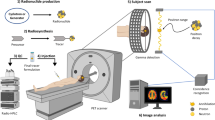Abstract
To meet the goals of converging molecular imaging with molecular biology and molecular medicine, there is a need to define the strategy and structure for perfecting the accuracy of functional images derived using PET. This also relates directly to how clinical research, diagnostic questions and challenges from the pharmaceutical industry are addressed. In order to exploit the sensitivity and specificity of PET, an integrated, multidisciplinary approach is imperative. The structure to provide this needs to been seen in the context of an institutional approach, collaborations within the academic and industrial sectors and the funding needed to meet the challenges of addressing difficult questions.
Similar content being viewed by others
References
Jones T. The role of PET within the spectrum of medical imaging.Eur J Nucl Med 1996; 23: 207–211
Beck RN. Overview of imaging science.Proc Natl Acad Sci 1993; 90: 9746–9750.
Larson P, Ulin J, Dalistrom K. Synthesis of [11C]methyliodide by iodination of [11C]methane.J Appl Radiat Isot 1996; in press
Bergman J, Johnstrom P, Haaparanta M, Solin S, Duelfer T, Stone-Elander S. Radiolabelling of 2-oxoquazenam with electrophilic18F prepared from [18G] fluoride.J Appl Radiat Isot 1995; 46: 1027–1028.
Pike WV. Positron-emitting radioligands for studies in vivoprobes for human psychopharmacology.J Psychopharmacol 1993: 72: 139–158.
Bloomfield PM, Rajeswaran S, Spinks TJ, Hume SP, Myers R, Ashworth S, Clifford KM, Jones WF, Byars LG, Young J, Andreaco M, Williams CW, Lammertsma AA, Jones T. The design and physical characteristics of a small animal positron emission tomograph.Phys Med Biol 1995; 40: 1105–1126.
Torres EM, Fricker RA, Hume SP, Myers R. Opacka-Juffry J, Ashworth S, Brooks D, Dunnett SB. Assessment of striatal graft viability in the rat in vivo using a small diameter PET scanner.NeuroReport 1995; 6: 2017–2021.
Smith T, Tong C, Lammertsma AA, Butler KR, Schnorr L, Watson JDG, Ramsey S, Clark JC, Jones T. Dosimetry of intravenously administered oxygen-15 labelled water in man: a model based on experimental human data from 21 subjects.Eur J Nucl Med 1994; 21: 1126–1134.
Melcher CL, Schweitzer JS. A promising new scintillator: cerium-doped lutetium oxyorthosilicate.Nucl Instr Methods Phys Res 1992; A314: 212–214.
Bentourkia M, Msaki P, Cadorette J, Lecomte R. Assessment of scatter components in multispectral PET imaging. In: Klaisner L, ed.Proceedings of EEE medical imaging conference. San Francisco, USA: Inst of Electrical and Electronic Engineers; 1993: 1505–1509.
Ranicar ASO, Williams CW, Schnorr L, Clark JC, Rhodes CG, Bloomfield PM, Jones T. The on-line monitoring of continuously withdrawn arterial blood during PET studies using a single BGO/photomultiplier assembly and non-stick tubing.Med Prog Technol 1991; 17: 259–264.
Reference deleted.
Townsend DW. Three dimensional PET: the current status and future prospects. In: Uemura K, Lassen NA, Jones T, Kanno I, eds. Quantification of brain function.Tracer kinetics and image analysis in brain PET. Amsterdam: Elsevier Science; 1993; 3–22.
Defrise M. A factorization method for the 3D X-ray transform.Inverse Problems 1995; 11: 983–994.
Doll J, Brix G, Bellemann ME, Ostertag HJ, Trojan H, Haberkorn U, Schmidlin P, Lorenz WJ. Improvement of spatial resolution in PET by implementing scanner characteristics in iterative image reconstruction algorithms. In: Richter J. ed.,Würzburg: Deutsche Gesellschaft für Medizinische Physik.
Meikle SR, Dahlborm M, Cherry SR. Attenuation correction using count-limited transmission data in positron emission tomography.J Nucl Med 1993; 34: 143–150.
Müller-Gartner HW, Links JM, Le prince JL, Bryan RN, McVergh E, Leal JP, Davatzikos C, Frost JJ. Measurement of radiotracer concentration in brain gray matter using positron emission tomography: MRI based correction for partial volume effect.J Cereb Blood Flow Metab 1992; 12: 571–583.
Nordstrom AL, Farde L, Pauli S, Litton JE, Halldin C. PET analysis of central [11C]raclopride binding in healthy young adults and schizophrenic patients - reliability and age effects.Hum Psychopharmacol 1992; 7: 157–165.
Yap JT, Cooper M, Chen CT, Cunningham VJ. Generative of parametric images using factor analysis of dynamic PET. In: Myers R, Cunningham V, Bailey D, Jones T, eds. Quantification of brain function using PET. San Diego: Academic Press; 1996: 292–296.
Ashburner J, Hasham J, Taylor C, Cunningham VJ, Jones T. In: Myers R, Cunningham V, Bailey D, Jones T, eds. Quantification of brain function using PET. San Diego: Academic Press; 1996: 301–306.
Cunningham VJ, Jones T. Spectral analysis of dynamic PET studies.J Cereb Blood Flow Metab 1993; 13: 15–23.
Bassingthwaighte JB, Beard DA. Fractal15O-labeled water washout from the heart.Circ Res 1995; 77: 1212–1222.
Friston KJ, Holmes AP, Worsley KJ, Poline JP, Frith CD, Frackowiak RSJ. Statistical parametric maps in functional imaging: a general linear approach.Hum Brain Mapping 1995; 2: 617–629.
Woods RP, Mazziotta JC, Cherry SR. MRI-PET registration with automated algorithm.J Comput Assist Tomogr 1993; 17: 536–546.
Myers R, Cunningham VJ, Bailey DL, Jones T. Quantification of brain function using PET. San Diego: Academic Press, 1996.
Lassen NA. A reappraisal of the relative merits of SPET and PET in the quantification of neuroreceptors: the advantage of a longer half-life!Eur J Nucl Med 1996; 23: 1–4.
Author information
Authors and Affiliations
Rights and permissions
About this article
Cite this article
Jones, T. The imaging science of positron emission tomography. Eur J Nucl Med 23, 807–813 (1996). https://doi.org/10.1007/BF00843711
Issue Date:
DOI: https://doi.org/10.1007/BF00843711




